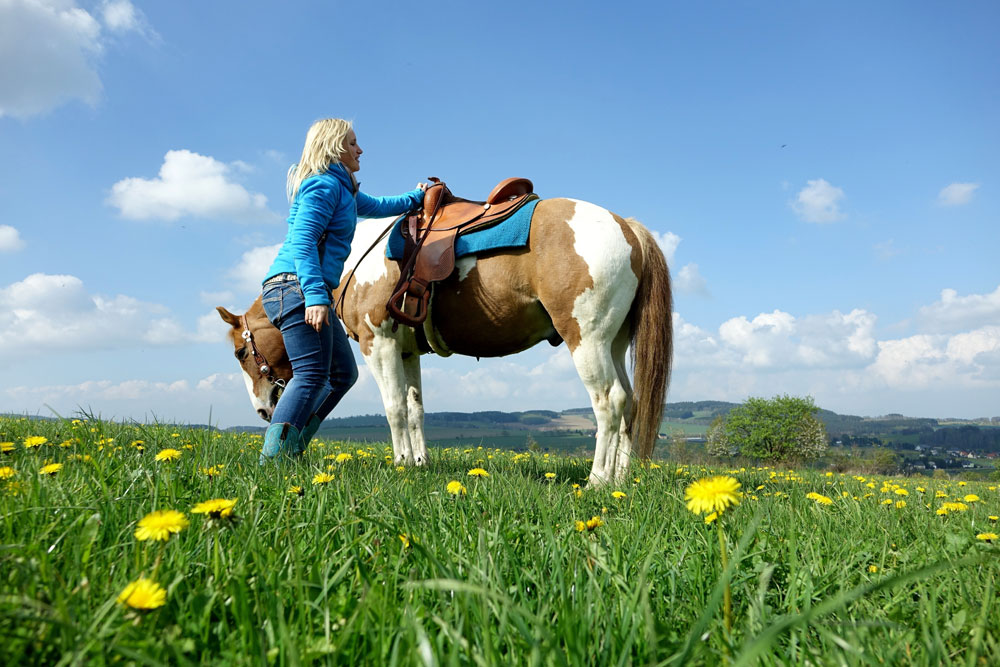If you’ve spent much time with horses, you’ve probably realized how many lessons they actually teach us. Read on for more lessons learned from horses.
You’ve probably uttered that sentence more than once. I certainly have, and I’m not embarrassed to admit it. While I’ve flirted with disaster on numerous occasions, and appeared a fool on others, I’ve at least learned not to repeat the misbegotten scenario. I’ll give you a few examples.

Lessons From Horses – Nighttime Knockout
First, there’s the time that I suffered a concussion and extensive facial bruising due to a lackadaisical approach while wrapping the legs of my mare Barbie. It happened midway through a multi-day show.
It was well after dark when I got Barbie back to her stall, and we were both exhausted. I even lacked the energy to remove my boots and helmet. Bleary-eyed, I allowed Barbie to dig into her dinner while I crouched down beside her, the bottle of liniment and pile of wraps by my feet.
Her front legs were neatly massaged and bundled up when I shifted to her hind legs. Barbie’s rhythmic munching, combined with my methodical rubbing of her tendons, lulled me into complacency. I plopped down on my butt, sitting like a lump in the straw, while I finished wrapping the last leg.
Suddenly I was on the other side of the stall, the back of my head slammed up against the wooden kick panel. I could feel pressure building on the bridge of my nose, the result of a hoof that had grazed the visor of my helmet.
Needless to say, I had some explaining to do to my trainer the next morning. Plus, I learned to never sit down next to a horse’s legs. Even if you’re tired and your horse is the sweetest pussycat in the world, don’t do it. Ever.
Lessons From Horses – Out of Reach
Then there was the time I put my horse’s ground-tying skills to the ultimate test and failed. Enamored of the local wildflowers, I’d made a habit of riding my Paint gelding, Wally, into the prairie and scrub oak to gather pretty petals. I’d dismount, drop Wally’s reins and gather wildflowers while he munched fresh grass.
On this particular day, Wally decided to venture off. It began with him moseying just a few steps forward, but as I reached for his reins he began to trot. I jogged after him until his long flaxen tail unfurled and he broke into a stiff-legged gallop. In an instant he was gone, disappearing over the hillside like a phantom Mustang.
I dropped my harvest and began running. Soon gasping for breath, I continued walking after him. My emotions ranged from anger at Wally to disappointment in myself, and settled on the abject fear that my beloved horse would eventually reach the paved road. What if he was struck by a car?
I must have trudged 5 miles or more in my boots and spurs until I finally caught up with him. Wally had safely jumped the wire wildlife fencing (which I suppose is a credit to our dabbling in eventing) and then galloped for several miles down the dirt shoulder that ran parallel to the road.
Fortunately, a couple puttering into town on their ATV spotted my horse. They’d been able to grab the reins that had eluded me. Aside from a wrenched shoe, Wally was fine. He almost seemed happy to see me. I rode him back to the barn and knew that I would never, ever trust his—or my—ground-tying skills again.
Halter Hang-up
The final lesson I’ll share is my most recent Equine Epiphany. It’s related to a basic rule of horse handling: “Always remove your horse’s halter when you turn him out.” The reason, of course, is that your horse could be mortally injured if the halter gets hung up or snagged on any type of fixture. I suppose I dismissed this rule for much of my life due to the convenience factor.
Then I moved to central Arizona.
There are several turnout paddocks at the stable where I now board Wally, and each one has a metal gate that suits the aesthetics of a medieval castle rather than a rustic ranch setting. Their sheer heft should have caused me to institute the halter removal rule, but it did not.
For several turnouts, Wally was fine with his halter on. He typically rolled and then hung out in the corner, gossiping with whichever horse was lounging in the neighboring paddock.
Yet this day he leaned against the gate, apparently testing its strength. He fiddled with its snap and chain. And then he tilted his head and somehow got his neck through the horizontal bars of the gate.
Startled by this predicament, he yanked himself back, and in the process his nylon halter looped around the gate’s latch. The horrified yelps from my fellow boarders sent me running back to the paddock.
I knew that if Wally were to resist violently and pull back, his hind legs could slip out from under him. The sudden shift of weight could break his neck. A thousand times over I kept hearing that horse handling commandment in my mind: “Always remove your horse’s halter when you turn him out.”
I took a deep breath and calmly walked toward Wally. I spoke to him softly and calculated every move of my body so as not to frighten him further. With one hand I rubbed his forehead. With the other I coaxed a few millimeters of slack from the crownpiece of his halter.
In one quick effort it unbuckled and Wally was free. Aside from some ruffled hair at the base of his ears, he was unmarked and unharmed. The moral of this story is, needless to say, “Always remove your horse’s halter when you turn him out.”
As you can see, a life spent with horses is a continuous process of learning important lessons. Please learn from your mistakes, and from mine as well.
This article originally appeared in the October 2018 issue of Horse Illustrated magazine. Click here to subscribe!





